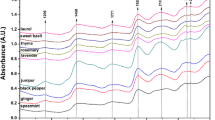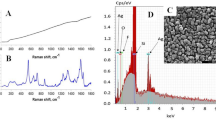Abstract
A soil habitat consists of a significant number of bacteria that cannot be cultivated by conventional means, thereby posing obvious difficulties in their classification and identification. This difficulty necessitates the need for advanced techniques wherein a well-compiled biomolecular database consisting of the already cultivable bacteria can be used as a reference in an attempt to link the noncultivable bacteria to their closest phylogenetic groups. Raman spectroscopy has been successfully applied to taxonomic studies of many systems like bacteria, fungi, and plants relying on spectral differences contributed by the variation in their overall biomolecular composition. However, these spectral differences can be obscured due to Raman signatures from photosensitive microbial pigments like carotenoids that show enormous variation in signal intensity hindering taxonomic investigations. In this study, we have applied laser-induced photobleaching to expel the carotenoid signatures from pigmented cocci bacteria. Using this method, we have investigated 12 species of pigmented bacteria abundant in soil habitats belonging to three genera mainly Micrococcus, Deinococcus, and Kocuria based on their Raman spectra with the assistance of a chemometric tool known as the radial kernel support vector machine (SVM). Our results demonstrate the potential of Raman spectroscopy as a minimally invasive taxonomic tool to identify pigmented cocci soil bacteria at a single-cell level.





Similar content being viewed by others
References
Baranska M, Schulz H, Kruger H, Quilitzsch R (2005) Chemotaxonomy of aromatic plants of the genus Origanum via vibrational spectroscopy. Anal Bioanal Chem 381:1241–1247
Baranski R, Baranska M, Schulz H, Simon PW, Nothnagel T (2006) Single seed Raman measurements allow taxonomical discrimination of Apiaceae accessions collected in gene banks. Biopolymers 81:497–505
Bocklitz T, Walter A, Hartmann K, Rösch P, Popp J (2011) How to pre-process Raman spectra for reliable and stable models. Anal Chim Acta 704:47–56
Boser BE, Guyon IM, Vapnik V (1992) A training algorithm for optimal margin classifiers. Proc Fifth Ann Workshop Comput Learn Theory 144–152
Britton G (1995) Structure and properties of carotenoids in relation to function. FASEB 9:1551–1558
Britton G, Liaaen Jensen S, Pfander H (2008) Carotenoids volume 4: natural functions. Springer, Germany
Burges CJC (1998) A tutorial on support vector machines for pattern recognition. Data Min Knowl Disc 2(2):121–167
Chan JW et al (2006) Micro-Raman spectroscopy detects individual neoplastic and normal hematopoietic cells. Biophys J 90:648–656
Cheng WT, Liu MT, Liu HN, Lin SY (2005) Micro Raman spectroscopy used to identify and grade human skin pilomatrixoma. Microsc Res Tech 68:75–79
Collins AM et al (2011) Carotenoid distribution in Living cells of Haematococcus pluvialis (Chlorophyceae). PLoS One 6(9)
Cortes C, Vapnik V (1995) Support-vector networks. Mach Learn 20(3):273–297
Dochow S et al (2011) Tumour cell identification by means of Raman spectroscopy in combination with optical traps and microfluidic environments. Lab Chip 11:1484–1490
Frank CJ, McCreecy RL, Redd DCB (1995) Raman spectroscopy of normal and diseased human breast tissues. Anal Chem 67:777–783
Harz M, Rösch P, Popp J (2009) Vibrational spectroscopy a powerful tool for the rapid identification of microbial cells at the single cell level. Cytometry A 75(2):104–13
Huang Z, McWilliams A, Lui M, McLean DI, Lam S, Zeng H (2003) Near-infrared Raman spectroscopy for optical diagnosis of lung cancer. Int J Cancer 107:1047–1052
Ji H-F (2010) Insight into the strong antioxidant activity of Deinoxanthin, a unique carotenoid in Deinococcus radiodurans. Int J Mol Sci 11:4506–4510
Janda JM, Abbott SL (2007) 16S rRNA gene sequencing for bacterial identification in the diagnostic laboratory: pluses, perils, and pitfalls. J Clin Microbiol 45:2761–2764
Janssen PH (2006) Identifying the dominant soil bacterial taxa in libraries of 16S rRNA and 16S rRNA genes. Appl Environ Microbiol 72:1719–1728
Jehlička J, Edwards HG, Oren A (2014) Raman spectroscopy of microbial pigments. Appl Environ Microbiol 80:3286–3295
Kim HY, Park HM, Lee CH (2012) Mass spectrometry-based chemotaxonomic classification of Penicillium species (P. echinulatum, P. expansum, P. solitum, and P. oxalicum) and its correlation with antioxidant activity. J Microbiol Methods 90:327–335
Kim M, Oh HC, Park SC, Chun J (2014) Towards a taxonomic coherence between average nucleotide identity and 16S rRNA gene sequence similarity for species demarcation of prokaryotes. Int J Syst Evol Microbiol 64:346–351
Klassen JL, Foght JM (2008) Differences in carotenoid composition among Hymenobacter and related strains support a tree like model of carotenoid evolution. Appl Environ Microbiol 74:2016–2024
Kloß S et al (2013) Culture independent Raman spectroscopic identification of urinary tract infection pathogens: a proof of principle study. Anal Chem 85:9610–9616
Kolijenovic S, Scut TB, Vincent A, Kros JM, Puppels GJ (2005) Detection of meningioma in dura mater by Raman spectroscopy. Anal Chem 77(24):7958–7965
Krafft C, Neudert L, Simat T, Salzer R (2005) Near infrared Raman spectra of human brain lipids. Spectrochim Acta A 61:1529–1535
Kusić D, Kampe B, Rösch P, Popp J (2014) Identification of water pathogens by Raman microspectroscopy. Water Res 48:179–189
Liaaen Jensen S, Andrewes AG (1972) Microbial carotenoids. Annu Rev Microbiol 26:225–248
Maquelin K et al (2009) Raman spectroscopic typing reveals the presence of carotenoids in Mycoplasma pneumonia. Microbiol Sgm 155:2068–2077
Meisel S, Stöckel S, Rösch P, Popp J (2014) Identification of meat associated pathogens via Raman microspectroscopy. Food Microbiol 38:36–43
Mignard S, Flandrois JP (2006) 16S rRNA sequencing in routine bacterial identification: a 30-month experiment. J Microbiol Methods 67:574–581
Movasaghi Z, Rehman S, Rehman IU (2007) Raman spectroscopy of biological tissues. Appl Spectrosc Rev 42:493–541
Naumann D (1998) Infrared and NIR Raman spectroscopy in medical microbiology. Proc SPIE 3257:245–257
Netzer R et al (2010) Biosynthetic pathway for γ-cyclic sarcinaxanthin in Micrococcus luteus :heterologous expression and evidence for diverse and multiple catalytic functions of C(50) carotenoid cyclises. J Bacteriol 192(21):5688–99
Notingher I, Green C, Dyer C (2004) Discrimination between ricin and sulphur mustard toxicity in vitro using Raman spectroscopy. J R Soc Interface 1:79–90
R Development core team (2008) R: a language and environment for statistical computing. R foundation for statistical computing, Vienna
Reddy GSN et al (2003) Kocuria polaris sp. nov., an orange-pigmented psychrophilic bacterium isolated from an Antarctic cyanobacterial mat sample. Int J Syst Evol Microbiol 53:183–187
Rinke C et al (2013) Insights into the phylogeny and coding potential of microbial dark matter. Nature 499:431–437
Rösch P et al (2005) Chemotaxonomic identification of single bacteria by micro-Raman spectroscopy: application to clean-room-relevant biological contaminations. Appl Environ Microbiol 71:1626–1637
Scholtes-Timmerman M, Willemse-Erix H, Schut TB, van Belkum A, Puppels G, Maquelin K (2009) A novel approach to correct variations in Raman spectra due to photo-bleachable cellular components. Analyst 134:387–393
Sigurdsson S, Philipsen PA, Hansen LK, Laesen L, Gniadecka M, Wulf HC (2004) Detection of skin cancer by classification of Raman spectra. IEEE Trans Biomed Eng 51(10):1784–93
Silge A, Schmacher W, Rösch P, da Costa Filho PA, Gerard C, Popp J (2014) Identification of water-conditioned Pseudomonas aeruginosa by Raman microspectroscopy on a single cell level. Syst Appl Microbiol 37:360–367
Silveira L Jr et al (2002) Correlation between near infrared Raman spectroscopy and the histopathological analysis of atheroscelerosis in human coronary arteries. Lasers Surg Med 30(4):290–7
Stewart EJ (2012) Growing unculturable bacteria. J Bacteriol 194:16
Stöckel S, Meisel S, Elschner M, Melzer F, Rösch P and Popp J (2014) Raman spectroscopic detection and identification of Burkholderia mallei and Burkholderia pseudomallei in feedstuff. Anal Bioanal Chem:1-10
Stone N, Kendall C, Smith J, Crow P, Barr H (2004) Raman spectroscopy for identification of epithelial cancers. Faraday Discuss 126:141–157
Van Der Heijden MG, Bardgett RD, van Straalen NM (2008) The unseen majority: soil microbes as drivers of plant diversity and productivity in terrestrial ecosystems. Ecol Lett 11:296–310
Pham VHT, Kim J (2012) Cultivation of unculturable soil bacteria. Trends Biotechnol 30:475–484
Ventura M, Canchaya C, Tauch A, Chandra G, Fitzgerald GF, Chater KF, van Sinderen D (2007) Genomics of Actinobacteria: tracing the evolutionary history of an ancient phylum. MMBR 71:495–548
Walter A, Schumacher W, Bocklitz T, Reinicke M, Rösch P, Kothe E, Popp J (2011) From bulk to single-cell classification of the filamentous growing Streptomyces bacteria by means of Raman spectroscopy. Appl Spectrosc 65:1116–1125
Walter A et al (2010) Analysis of the cytochrome distribution via linear and nonlinear Raman spectroscopy. Analyst 135:908–917
Withnall R, Chowdhry BZ, Silver J, Edwards HG, de Oliveira LF (2003) Raman spectra of carotenoids in natural products. Spectrochim Acta A 59:2207–2212
Whitman WB, Coleman DC, Wiebe WJ (1998) Prokaryotes: the unseen majority. PNAS 95:6578–6583
Xing YL, Bao JW, Cheng YJ, Shuang JL (2007) Micrococcus flavus sp. nov. isolated from activated sludge in a bioreactor. Int J Syst Evol Microbiol 57:66–69
Zhao GZ et al (2009) Micrococcus yunnanensis sp. nov., a novel actinobacterium isolated from surface-sterilized Polyspora axillaris roots. Int J Syst Evol Microbiol 59:2383–2387
Acknowledgments
This work is financially supported by the German Research Foundation (DFG) under the grant GRK 1257/2: “Alteration and element mobility at the microbe-mineral interface.”
Author information
Authors and Affiliations
Corresponding author
Additional information
Responsible editor: Philippe Garrigues
Rights and permissions
About this article
Cite this article
Kumar, V., Kampe, B., Rösch, P. et al. Classification and identification of pigmented cocci bacteria relevant to the soil environment via Raman spectroscopy. Environ Sci Pollut Res 22, 19317–19325 (2015). https://doi.org/10.1007/s11356-015-4593-5
Received:
Accepted:
Published:
Issue Date:
DOI: https://doi.org/10.1007/s11356-015-4593-5




